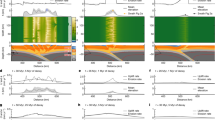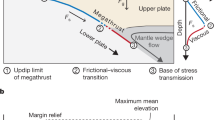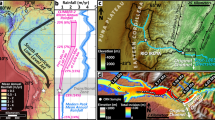Abstract
Simple physical arguments, analogue experiments and numerical experiments all suggest that the internal dynamics of actively deforming collisional mountain ranges are influenced by climate. However, obtaining definitive field evidence of a significant impact of climate on mountain building has proved challenging. Spatial correlations between intense precipitation or glaciation and zones of rapid rock-uplift have indeed been documented in numerous mountain ranges, and are consistent with model predictions. More compelling evidence — such as tectonic changes in response to (rather than just coincident with) climate change — has, however, rarely been documented. Triggered by a climate-driven increase in erosion rate, friction-dominated mountain ranges are expected to show a number of simultaneous responses: a decrease in the width of the range, a temporary increase in sediment yield, a persistent increase in the rate of rock uplift and a reduction in the subsidence rate of surrounding basins. The most convincing field evidence for such a coordinated response of a mountain range to climate change comes from the European Alps and the St Elias range of Alaska.
This is a preview of subscription content, access via your institution
Access options
Subscribe to this journal
Receive 12 print issues and online access
$259.00 per year
only $21.58 per issue
Buy this article
- Purchase on Springer Link
- Instant access to full article PDF
Prices may be subject to local taxes which are calculated during checkout




Similar content being viewed by others
Change history
30 August 2009
In the version of this Review originally published, Fig. 4d was incorrect. This has now been corrected in the HTML and PDF versions of the Review.
References
Dahlen, F. A., Suppe, J. & Davis, D. Mechanics of fold-and-thrust belts and accretionary wedges: Cohesive Coulomb theory. J. Geophys. Res. 89, 10087–10101 (1984).
Davis, D., Suppe, J. & Dahlen, F. A. Mechanics of fold-and-thrust belts and accretionary wedges. J. Geophys. Res. 88, 1153–1172 (1983).
Stockmal, G. S. Modeling of large-scale accretionary wedge deformation. J. Geophys. Res. 88, 8271–8287 (1983).
Jamieson, R. A. & Beaumont, C. Orogeny and metamorphism: A model for deformation and pressure-temperature-time paths with applications to the central and southern Appalachians. Tectonics 7, 417–445 (1988).
Barr, T. D., Dahlen, F. A. & McPhail, D. C. Brittle frictional mountain building. 3. Low-grade metamorphism. J. Geophys. Res. 96, 10319–10338 (1991).
Dahlen, F. A. & Suppe, J. in Processes in Continental Lithospheric Deformation: Geological Society of America Special Paper 218 (eds Clark, S. P. Jr, Burchfiel, B. C. & Suppe, J.) 161–178 (Geological Society of America, 1988).
Koons, P. O. The two-sided orogen: Collision and erosion from the sand box to the Southern Alps, New Zealand. Geology 18, 679–682 (1990).
Willett, S. D. Orogeny and orography: The effects of erosion on the structure of mountain belts. J. Geophys. Res. 104, 28957–28981 (1999).
Willett, S. D., Beaumont, C. & Fullsack, P. Mechanical model for the tectonics of doubly vergent compressional orogens. Geology 21, 371–374 (1993).
Beaumont, C., Fullsack, P. & Hamilton, J. in Thrust Tectonics (ed. McClay, K. R) 1–18 (Chapman & Hall, 1992).
Beaumont, C., Kamp, P., Hamilton, J. & Fullsack, P. The continental collision zone, South Island, New Zealand: Comparison of geodynamical models and observations. J. Geophys. Res. 101, 3333–3359 (1996).
Batt, G. E. & Braun, J. The tectonic evolution of the Southern Alps, New Zealand: Insights from fully thermally coupled dynamical modelling. Geophys. J. Int. 136, 403–420 (1999).
Montgomery, D. R., Balco, G. & Willett, S. D. Climate, tectonics, and the morphology of the Andes. Geology 29, 579–582 (2001).
Isacks, B. L. Uplift of the Central Andean Plateau and bending of the Bolivian Orocline. J. Geophys. Res. 93, 3211–3231 (1988).
Beaumont, C., Jamieson, R. A., Nguyen, M. H. & Lee, B. Himalayan tectonics explained by extrusion of a low-viscosity crustal channel coupled to focused surface denudation. Nature 414, 738–742 (2001).
Koons, P. O., Zeitler, P. K., Chamberlain, C., Craw, D. & Meltzer, A. S. Mechanical links between erosion and metamorphism in Nanga Parbat, Pakistan Himalaya. Am. J. Sci. 302, 749–773 (2002).
Zeitler, P. K. et al. Crustal reworking at Nanga Parbat, Pakistan: Metamorphic consequences of thermal-mechanical coupling facilitated by erosion. Tectonics 20, 712–728 (2001).
Beaumont, C., Kooi, H. & Willett, S. in Geomorphology and Global Tectonics (ed. Summerfield, M. A) 29–55 (Wiley, 2000).
Persson, K. S. & Sokoutis, D. Analogue models of orogenic wedges controlled by erosion. Tectonophysics 356, 323–336 (2002).
Hoth, S., Adam, J., Kukowshi, N. & Oncken, O. in Tectonics, Climate, and Landscape Evolution: Geological Society of America Special Paper 398 (eds Willett, S. D., Hovius, N., Brandon, M. & Fisher, D. M.) 201–225 (Penrose Conference Series, Geological Society of America, 2006).
Mugnier, J. L. et al. Thrust geometry controlled by erosion and sedimentation: A view from analogue models. Geology 25, 427–430 (1997).
Persson, K. S., Garcia-Castellanos, D. & Sokoutis, D. River transport effects on compressional belts: First results from an integrated analogue-numerical model. J. Geophys. Res. 109, 10.1029/2002JB002274 (2004).
Konstantinovskaia, E. & Malavieille, J. Erosion and exhumation in accretionary orogens: Experimental and geological approaches. Geochem. Geophy. Geosy. 6, 10.1029/2004GC000794 (2005).
Simpson, G. Dynamic interactions between erosion, deposition, and three-dimensional deformation in compressional fold belt settings. J. Geophys. Res. 109, 10.1029/2003JF000111 (2004).
Stolar, D. B., Roe, G. H. & Willett, S. Controls on the patterns of topography and erosion rate in a critical orogen. J. Geophys. Res. 112, 10.1029/2006JF000713 (2007).
Naylor, M. & Sinclair, H. D. Punctuated thrust deformation in the context of doubly vergent thrust wedges: Implications for the localization of uplift and exhumation. Geology 35, 559–562 (2007).
Hilley, G. E., Strecker, M. & Ramos, V. A. Growth and erosion of fold-and-thrust belts with an application to the Aconcagua fold and thrust belt, Argentina. J. Geophys. Res. 109, 10.1029/2002JB002282 (2004).
Whipple, K. & Meade, B. J. Controls on the strength of coupling among climate, erosion, and deformation in two-sided, frictional orogenic wedges at steady state. J. Geophys. Res. 109, 10.1029/2003JF000019 (2004).
Whipple, K. X. & Meade, B. J. Orogen response to changes in climatic and tectonic forcing. Earth Planet. Sci. Lett. 243, 218–228 (2006).
Roe, G. H., Stolar, D. R. & Willett, S. D. in Tectonics, Climate, and Landscape Evolution: Geological Society of America Special Paper 398 (eds Willett, S. D., Hovius, N., Brandon, M. & Fisher, D. M.) 227–239 (Penrose Conference Series, Geological Society of America, 2006).
Stolar, D. R., Willett, S. D. & Roe, G. H. in Tectonics, Climate, and Landscape Evolution: Geological Society of America Special Paper 398 (eds Willett, S. D., Hovius, N., Brandon, M. & Fisher, D. M.) 241–250 (Penrose Conference Series, Geological Society of America, 2006).
Tomkin, J. H. & Roe, G. H. Climate and tectonic controls on glaciated critical-taper orogens. Earth Planet. Sci. Lett. 262, 385–397 (2007).
Ahnert, F. Functional relationships between denudation, relief, and uplift in large mid-latitude drainage basins. Am. J. Sci. 268, 243–263 (1970).
Montgomery, D. R. & Brandon, M. T. Topographic controls on erosion rates in tectonically active mountain ranges. Earth Planet. Sci. Lett. 201, 481–489 (2002).
Kooi, H. & Beaumont, C. Escarpment evolution on high-elevation rifted margins: Insights derived from a surface processes model that combines diffusion, advection, and reaction. J. Geophys. Res. 99, 12191–112209 (1994).
Densmore, A. L., Ellis, M. A. & Anderson, R. S. Landsliding and the evolution of normal-fault-bounded mountains. J. Geophys. Res. B 103, 15203–215219 (1998).
Small, E. E. & Anderson, R. S. Geomorphically driven Late Cenozoic rock uplift in the Sierra Nevada, California. Science 270, 277–280 (1995).
Pazzaglia, F. J. & Brandon, M. T. Macrogeomorphic evolution of the post-Triassic Appalachian mountains determined by deconvolution of the offshore basin sedimentary record. Basin Res. 8, 255–278 (1996).
Turcotte, D. L. & Schubert, G. Geodynamics: Applications of Continuum Physics to Geological Problems (Wiley, 1982).
Bonnet, S. & Crave, A. Landscape response to climate change: Insights from experimental modeling and implications for tectonics versus climatic uplift of topography. Geology 31, 123–126 (2003).
Willett, S. D. & Brandon, M. T. On steady states in mountain belts. Geology (Boulder) 30, 175–178 (2002).
Whipple, K., Kirby, E. & Brocklehurst, S. Geomorphic limits to climatically induced increases in topographic relief. Nature 401, 39–43 (1999).
Adams, J. in Tectonic Geomorphology (eds Morisawa, M. & Hack, J. T.) 105–128 (Allen and Unwin, 1985).
Suppe, J. Mechanics of mountain-building and metamorphism in Taiwan. Geol. Soc. of China Mem. 4, 67–89 (1981).
Brandon, M. T., Roden-Tice, M. K. & Garver, J. I. Late Cenozoic exhumation of the Cascadia accretionary wedge in the Olympic Mountains, northwest Washington State. Geol. Soc. Am. Bull. 110, 985–1009 (1998).
Pazzaglia, F. J. & Brandon, M. T. A fluvial record of long-term steady-state uplift and erosion across the Cascadia forearc high, western Washington State. Am. J. Sci. 301, 385–431 (2001).
Cederbom, C. E., Sinclair, H. D., Schlunegger, F. & Rahn, M. K. Climate-induced rebound and exhumation of the European Alps. Geology 32, 709–712 (2004).
Champagnac, J. D., Molnar, P., Anderson, R. S., Sue, C. & Delacou, B. Quaternary erosion-induced isostatic rebound in the western Alps. Geology 35, 195–198 (2007).
Kuhlemann, J. Post-collisional sediment budget of circum-Alpine basins (Central Europe). Memorie di Scienze Geologiche Padova 52, 1–91 (2000).
Zhang, P., Molnar, P. & Downs, W. R. Increased sedimentation rates and grain sizes 2–4 Myr ago due to the influence of climate change on erosion rates. Nature 410, 891–897 (2001).
Wager, L. R. The Arun river drainage pattern and the rise of the Himalaya. Geogr. J. 89, 239–250 (1937).
Simpson, G. D. H. Modelling interactions between fold-thrust belt deformation, foreland flexure and surface mass transport. Basin Res. 18, 125–143 (2006).
Berger, A. L. et al. Quaternary tectonic response to intensified glacial erosion in an orogenic wedge. Nature Geosci. 1, 793–799 (2008).
Willett, S. D., Schlunegger, F. & Picotti, V. Messinian climate change and erosional destruction of the central European Alps. Geology 34, 613–616 (2006).
Kuhlemann, J., Frisch, W., Szekely, B., Dunkl, I. & Kazmer, M. Post-collisional sediment budget history of the Alps: tectonic versus climatic control. Int. J. Earth Sci. 91, 818–837 (2002).
Driscoll, N. W. & Haug, G. H. A short circuit in thermohaline circulation: A cause for northern hemisphere glaciation? Science 282, 436–438 (1998).
Schmid, S. M., Pfiffner, O. A., Froitzheim, N., Schonborn, G. & Kissling, E. Geophysical-geological transect and tectonic evolution of the Swiss-Italian Alps. Tectonics 15, 1036–1064 (1996).
Calais, E., Nocquet, J. M., Jouanne, F. & Tardy, M. Current strain regime in the Western Alps from continuous Global Positioning System measurements, 1996–2001 Geology 30, 651–654 (2002).
Delacou, B., Sue, C., Champagnac, J. D. & Burkhard, M. Present-day geodynamics in the bend of the western and central Alps as constrained by earthquake analysis. Geophys. J. Int. 158, 753–774 (2004).
Dadson, S. J. et al. Links between erosion, runoff variability and seismicity in the Taiwan orogen. Nature 426, 648–651 (2003).
Hovius, N., Stark, C. P., Chu, H. T. & Lin, J. C. Supply and removal of sediment in a landslide-dominated mountain belt: Central Range, Taiwan. J. Geol. 108, 73–89 (2000).
Reiners, P. W. & Brandon, M. T. Using thermochronology to understand orogenic erosion. Annu. Rev. Earth Planet. Sci. 34, 419–466 (2006).
Tricart, P., Van der Beek, P., Schwartz, S. & Labrin, E. Diachronous late-stage exhumation across the western Alpine arc: constraints from apatite fission-track thermochronology between the Pelvoux and Dora-Maira Massifs. J. Geol. Soc. 164, 163–174 (2007).
Michalski, I. & Soom, M. The Alpine thermo-tectonic evolution of the Aar and Gotthard massifs, central Switzerland: Fission track ages on zircon and apatite and K-Ar mica ages. Schweiz. Miner. Petrogr. 70, 373–387 (1990).
Leloup, P. H., Arnaud, N., Sobel, E. R. & Lacassin, R. Alpine thermal and structural evolution of the highest external crystalline massif: The Mont Blanc. Tectonics 24, 10.1029/2004TC001676 (2005).
Hodges, K., Hurtado, J. M. & Whipple, K. Southward extrusion of Tibetan crust and its effect on Himalayan tectonics. Tectoncis 20, 799–809 (2001).
Beaumont, C., Jamieson, R. A., Nguyen, M. H. & Medvedev, S. Crustal channel flows: 1. Numerical models with applications to the tectonics of the Himalayan-Tibetan orogen. J. Geophys. Res. Solid Earth 109, 10.1029/2003JB002809 (2004).
Nelson, K. D. et al. Partially molten middle crust beneath southern Tibet: Synthesis of Project INDEPTH Results. Science 274, 1684–1688 (1996).
Finnegan, N. J. et al. Coupling of rock uplift and river incision in the Namche Barwa-Gyala Peri massif, Tibet. Geol. Soc. Am. Bull. 120, 142–155 (2008).
Beaumont, C., Jamieson, R. A. & Nguyen, M. H. Erosion-induced reactivation of the main central thrust zone: Model and implications for channel flow in the Himalayan-Tibetan system. Eos Trans. AGU 88, T34C-01 (2007).
Avouac, J. P. in Advances in Geophysics Vol. 46 (eds Dmowska, R. & Saltzman, B) 1–80 (Elsevier, 2003).
Bollinger, L., Henry, P. & Avouac, J. P. Mountain building in the Nepal Himalaya: Thermal and kinematic model. Earth Planet. Sci. Lett. 244, 58–71 (2006).
Burbank, D. W. et al. Decoupling of erosion and precipitation in the Himalayas. Nature 426, 652–655 (2003).
Reiners, P. W., Ehlers, T. A., Mitchell, S. G. & Montgomery, D. R. Coupled spatial variation in precipitation and long-term erosion rates across the Washington Cascades. Nature 426, 645–647 (2003).
Wobus, C. W., Hodges, K. & Whipple, K. Has focused denudation at the Himalayan topographic front sustained active thrusting near the Main Central Thrust? Geology 31, 861–864 (2003).
Bookhagen, B. & Burbank, D. W. Topography, relief, and TRMM-derived rainfall variations along the Himalaya. Geophys. Res. Lett. 33, 10.1029/2006GL026037 (2006).
Thiede, R. C., Bookhagen, B., Arrowsmith, J. R., Sobel, E. R. & Strecker, M. R. Climatic control on rapid exhumation along the Southern Himalayan front. Earth Planet. Sci. Lett. 222, 791–806 (2004).
Wobus, C. W., Heimsath, A. M., Whipple, K. & Hodges, K. Active out-of-sequence thrust faulting in the central Nepalese Himalaya. Nature 434, 1008–1011 (2005).
Wobus, C. W., Whipple, K. X. & Hodges, K. V. Neotectonics of the central Nepalese Himalaya: Constraints from geomorphology, detrital Ar-40/Ar-39 thermochronology, and thermal modeling. Tectonics 25, 10.1029/2005TC001935 (2006).
Vannay, J.-C. et al. Miocene to Holocene exhumation of metamorphic crustal wedges in the NW Himalaya: Evidence for tectonic extrusion coupled to fluvial erosion. Tectonics 23, 10.1029/2002TC001429 (2004).
Fuller, C. W., Willett, S., Fisher, D. & Lu, C. Y. A thermomechanical wedge model of Taiwan constrained by fission-track thermochronometry. Tectonophysics 425, 1–24 (2006).
Blythe, A. E., Burbank, D. W., Carter, A., Schmidt, K. & Putkonen, J. Plio-Quaternary exhumation history of the central Nepalese Himalaya: 1. Apatite and zircon fission track and apatite [U-Th]/He analyses. Tectonics 26, 10.1029/2006TC001990 (2007).
Hallet, B., Hunter, L. & Bogen, J. Rates of erosion and sediment evacuation by glaciers: a review of field data and their implications. Global Planet. Change 12, 213–235 (1996).
Brozovic, N., Burbank, D. & Meigs, A. Climatic limits on landscape development in the Northwestern Himalaya. Science 276, 571–574 (1997).
Brocklehurst, S. & Whipple, K. Glacial erosion and relief production in the Eastern Sierra Nevada, California. Geomorphology 42, 1–24 (2002).
Roe, G. H. Orographic precipitation. Annu. Rev. Earth Planet. Sci. 33, 645–671 (2005).
Biswas, S. et al. Exhumation and uplift of the Shillong plateau and its influence on the eastern Himalayas: New constraints from apatite and zircon (U-Th-[Sm])/He and apatite fission track analyses. Tectonics 26, 10.1029/2007TC002125 (2007).
Grujic, D. et al. Climatic forcing of erosion, landscape, and tectonics in the Bhutan Himalayas. Geology 34, 801–804 (2006).
Strecker, M. R. et al. Tectonics and climate of the southern central Andes. Annu. Rev. Earth Planet. Sci. 35, 747–787 (2007).
Huntington, K. W., Blythe, A. E. & Hodges, K. V. Climate change and Late Pliocene acceleration of erosion in the Himalaya. Earth Planet. Sci. Lett. 252, 107–118 (2006).
Kroon, D., Steens, T. & Troelstra, S. R. Onset of monsoon related upwelling in the western Arabian Sea as revealed by planktonic foraminifers. Proc. Ocean Drilling Program Scientific Results 117, 257–263 (1991).
Zhisheng, A., Kutzbach, J. E., Prell, W. & Porter, S. C. Evolution of Asian monsoons and phased uplift of the Himalaya-Tibetan plateau since Late Miocene times. Nature 411, 62–66 (2001).
Hodges, K., Wobus, C. W., Ruhl, K., Schildgen, T. & Whipple, K. Quaternary deformation, river steepening, and heavy precipitation at the front of the Higher Himalayan ranges. Earth Planet. Sci. Lett. 220, 379–389 (2004).
Thiede, R. C., Ehlers, T. A., Bookhagen, B. & Strecker, M. R. Erosional variability along the northwest Himalaya. J. Geophys. Res. 10.1029/2008JF001010 (in the press).
Acknowledgements
I am indebted to colleagues and students for insightful discussions, in particular S. Willett, C. Beaumont, B. Meade, D. Stolar and K. Hodges. Discussions with members of the Earth System Evolution Program of the Canadian Institute for Advanced Research have been pivotal in my understanding of the interaction of climate and tectonics. A review by C. Beaumont helped improve an earlier manuscript. Funding from NSF EAR programmes in Continental Dynamics, Geomorphology and Land Use Dynamics and Tectonics supported the development of ideas in this review.
Author information
Authors and Affiliations
Corresponding author
Supplementary information
Supplementary information
Supplementary information (PDF 256 kb)
Rights and permissions
About this article
Cite this article
Whipple, K. The influence of climate on the tectonic evolution of mountain belts. Nature Geosci 2, 97–104 (2009). https://doi.org/10.1038/ngeo413
Received:
Accepted:
Published:
Issue Date:
DOI: https://doi.org/10.1038/ngeo413
This article is cited by
-
Coupled Surface Process and Orographic Precipitation Model for the Landscape Evolution of the Himalayas
Journal of Earth Science (2024)
-
Milankovitch-paced erosion in the southern Central Andes
Nature Communications (2023)
-
Morphotectonic development of surface karst in Western Taurus (Türkiye)
Carbonates and Evaporites (2023)
-
Climatic control on the location of continental volcanic arcs
Scientific Reports (2022)
-
Alpine rockwall erosion patterns follow elevation-dependent climate trajectories
Communications Earth & Environment (2022)



